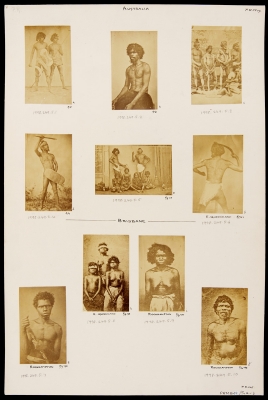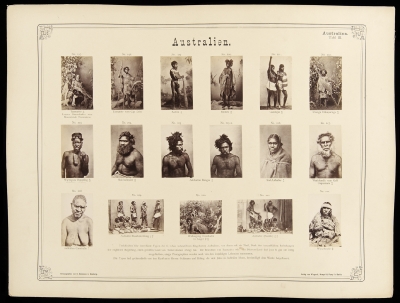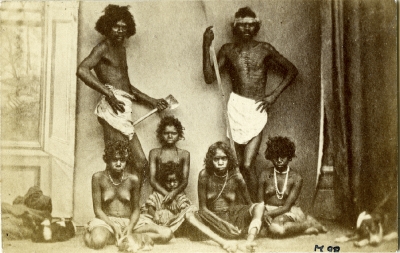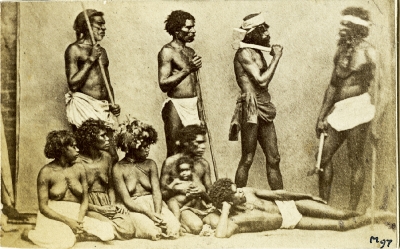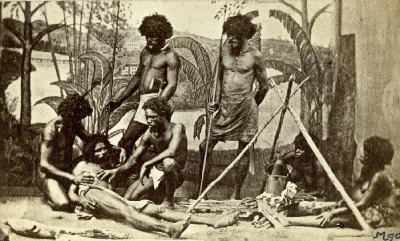To search the RPR site click here
Object biographies
Christopher Morton
Curator of Photographs and Manuscripts, Pitt Rivers Museum
Box 49 (Australia) in the PRM’s photograph collections was put together by Curator Henry Balfour around 1931 as part of his project to create a systematic research resource out the photographs that had accumulated by that time within the Museum (Edwards & Hart 2004, Morton forthcoming). The ten photographs illustrated here were pasted at that time onto one of the uniform mounts that make up this series. This research note summarises the available documentation for this group of early Australian photographs, as well as some initial research findings about them. The research forms part of a wider Australian Research Council project, ‘Globalization, Photography, and Race: the Circulation and Return of Aboriginal Photographs in Europe' led by Jane Lydon at Monash University, and which the PRM and several other European museums are participating in as collaborating partners.
The ten cartes-de-visite are all pasted onto a cardboard mount forming one card within the geographical series. The fact that they were all kept together in this way suggests that Balfour knew that they were an associated group. The bottom right hand corner of the card is inscribed ‘P.R. coll.’ which has elsewhere in the collection (with some exceptions) indicated that the photographs formed part of the founding collection of the Museum, and thus originally collected by A.H.L.F. Pitt-Rivers. The photographs are organized into two groups. The first six are underlined with the title ‘Brisbane’, although none of the individual images are labelled such. The lower four portraits are individually labelled, three as ‘Rockhampton’ and one as ‘East Queensland’. In fact, all four have been specifically identified as relating to Rockhampton (Sumner 1986: 158).
Published information by Sumner (1986) and Theye (2004) has confirmed that this set of ten photographs are copies of an original set of nineteen carte-de-visite format photographs collected sometime between 1863 and 1872 in Queensland by Amalie Dietrich for the Godeffroy Museum, Hamburg. Sumner (1986: 159) suggests that the Brisbane set were collected during 1863-5 since this was the period that Dietrich was based there. However, it is possible that they were collected as late as 1872 on her journey back. The Brisbane photographs have also been suggested as the work of the Daniel Marquis studio, whereas those from Rockhampton have been suggested as by Joseph Wilder (Aird 2010). Aird notes that Dietrich visited Rockhampton between 1866-7, thus providing a terminus ante quem for these prints.
The fact that these two groupings were made by Balfour suggests that both Brisbane and Rockhampton identifications were somewhere documented for these photographs. In general, Balfour was meticulous about recording relevant information from print backs onto the card beside a photograph, and this is suggested by the mixed and patchy data recorded on the card. For instance, all but one photograph have an identifier (e.g. E/4) recorded, and half of them have individual locations transcribed. In keeping with Balfour’s practice elsewhere in the collection, this suggests that all individual labels were transcribed from the print backs at the time they were pasted onto the board around 1931.
The identifiers themselves fall into two categories. One set connects them with their former life in Pitt-Rivers’s collection (E/1 – E/10). It is not yet known when this set of identifiers was given to the photographs, but other sets of photographs carry similar identifiers, and it can be assumed that they pre-date their transfer to Oxford in 1884. Although a number of other sets of photographs (such as from Fiji and Brittany) are mentioned in the delivery catalogues, this set is not. The second set of identifiers (e.g. 189), recorded next to six of the photographs, are Godeffroy Museum numbers, which can be cross-referenced with the published Godeffroy catalogue (Schmeltz and Krause 1881). The original Godeffroy numbers for the remaining 4 photographs were identified using this catalogue, as well as cross-referencing the documentation and images published by Sumner (1986: 158).
Although Sumner (1986: 160) suggests that two prints in the Archer album in the John Oxley Library (JOL), Brisbane, are likely to be Godeffroy nos 41 and 54 from the Dietrich set, the evidence from the European collections suggests not. The version of Godeffroy 41 in the JOL (Sumner 1986: 162) is slightly different to that purchased by Pitt-Rivers from the Godeffroy (1998.249.5.3), which is probably from the Dietrich set. Likewise, the version of Godeffroy 54 in the JOL (Sumner 1986: 163) is somewhat different to the version in the Museum Volkenkunde in Leiden, which is presumably from the original Dietrich set. Theye (2004: 260) suggests that a further copy of Godeffroy 54 is held in Museum für Völkerkunde, Hamburg, which should be compared with both versions.
Of the original set of nineteen collected by Amalie Dietrich for the Godeffroy Museum, Pitt-Rivers purchased ten images, six from Brisbane and four from Rockhampton. Pitt-Rivers must have bought the photographs during his visit to Germany and Scandinavia with George Rolleston in the summer of 1879 (see separate article on this journey). It is known that ‘duplicates’ of the Godeffroy photograph collection were being offered for sale as early as 1874 (Sumner 1986: 157). The selection of ten images might well have been made on the basis that they best illustrated Aboriginal people holding or using weapons and other material culture, since of the nine Brisbane images that Pitt-Rivers did not purchase, only three show weapons or other material culture (Sumner 1986: 158), whereas all but one of the six he did purchase include such items. In total, Pitt-Rivers purchased around seventy-two photographs from the Godeffroy Museum in 1879, as well as numerous cartes-de-visite from studios in Germany and Scandinavia (see separate article on the founding collection of photographs).
Indigenous Australians were of some research interest to Pitt-Rivers, usually appearing as the most primitive element within his typological series ‘because they assimilate most closely to the natural forms’ (Lane Fox 1875: 9) – a comment that echoed Herbert Spencer’s analogy between simple biological and cultural forms. Most of Pitt-Rivers’ photographs were originally displayed in the South Kensington Museum in a section developed to illustrate physical anthropology, ‘the various races of mankind’. Also on display in this section were two skulls from Australia (see separate article on this section of the 1874 display catalogue).
Dammann’s copies of the Dietrich and Godeffroy collections
There are three photographs elsewhere in box 49 that are closely related to the Dietrich set, and which are copies made by the Hamburg-based photographer Carl Dammann, who was copying material for the Berliner Gesellschaft für Anthropologie, Ethnologie und Urgeschichte, eventually published in his major work Anthropologisches-Ethnologisches Album in Photographien (AEA) (1872-4). The Dammann material in the PRM was purchased from the Estate of Friedrich Dammann (Carl Dammann’s brother and the continuer of his work) in 1901. The PRM collection has one example of a Dammann copy of the Dietrich set (1998.249.7.13 – see below), and there are a number of other examples of Dammann copies of material from the Godeffroy collection. This is possible evidence of collaboration by the Godeffroy Museum in the Berliner Gesellschaft project undertaken by Dammann, or else points to the Berliner Gesellschaft having acquired copies of the Godeffroy material, which it then shared with Dammann. Of the three copies by Dammann discussed below, two were published in Table 3 of the AEA. It should be noted that the PRM holds prints of around 30 or more other copies made by Dammann of early Australian photographs (i.e. before 1874) and this set will be the focus of future research.
[1998.249.7.13] This print was purchased from the Estate of Friedrich Dammann (Carl Dammann’s brother and the continuer of his work) in 1901, and is the same image as Godeffroy no. 53 in the PRM founding collection [1998.249.5.5]. The original image has been suggested as the work of the Daniel Marquis studio in Brisbane. The caption in pencil on the PRM mount, presumably copied from a note on the back of the print, reads “Family at Home”. This image was published by Dammann in the AEA (1872-4) within Table 3 (Australia), with the caption “Australier (Familie)”. Theye (2004: 260) notes that another copy of Godeffroy no. 53 is in the Museum für Völkerkunde, Hamburg.
[1998.249.7.14] This print was also purchased from the Estate of Friedrich Dammann in 1901. It is closely related to Godeffroy no. 55 which includes a European man to the right of the group (published in Sumner 1986: 165), copies of which appear in a number of European museums (Theye 2004: 260). This Dammann print is labelled “Bride Capture” on the PRM mount. The original which Dammann copied does not seem to be part of the Dietrich set, but is also possibly the work of the Daniel Marquis studio in Brisbane, and was possibly a print acquired by the Berliner Gesellschaft in the same period. This image was published by Dammann in his Anthropologisches-Ethnologisches Album in Photographien (1872-4) in Table 3 (Australia), with the caption “Australier Brautbewerbung”, i.e. “Australian courtship”.
[1998.249.7.15] This print was also purchased from the Estate of Friedrich Dammann in 1901. It is almost identical to one in the John Oxley Library, Brisbane (published in Sumner 1986: 163), but with the standing men keeping their heads down instead of facing the camera. It is also thereby probably the work of the Daniel Marquis studio in Brisbane. Sumner proposes that the John Oxley Library print may be the same image as Godeffroy no. 54. In fact there seem to be several slight variations of this scene, including the version in the Archer album in the John Oxley Library, the version in Leiden, and this Dammann copy of an unknown original, possibly collected by the Berliner Gesellschaft. These variations show that several versions of this grouping were produced by the Daniel Marquis studio and disseminated widely. Dammann did not however use this image in his Anthropologisches-Ethnologisches Album in Photographien (1872-4).
The Dietrich set in the PRM Founding Collection
The following accession numbers (for example 1998.249.5.1) can be seen if you click on the first image shown on this page, to zoom the image, and look at each of the photographs to see the faint numbers below.
|
PRM no. |
Pitt-Rivers no. |
Godeffroy catalogue no. |
|
1998.249.5.1 |
E/5 |
48 |
|
1998.249.5.2 |
E/8 |
51 |
|
1998.249.5.3 |
Not recorded, but E/2 |
41
This version is slightly different to that in the Archer album, John Oxley Library, published by Sumner (1986: 162). |
|
1998.249.5.4 |
E/4 |
50 |
|
1998.249.5.5 |
E/3 |
53
This photograph was copied by Carl Dammann and published in the AEA (1872-4). |
|
1998.249.5.6 |
E/1 |
42 |
|
1998.249.5.7 |
E/7 |
192 |
|
1998.249.5.8 |
E/6 |
193 |
|
1998.249.5.9 |
E/9 |
190 |
|
1998.249.5.10 |
E/10 |
189 |
References
Aird, M. 2010. Aboriginal Visual History Project. Queensland Report – August 2010.
Edwards, E. and J. Hart. 2004. Mixed box: the cultural biography of a box of ‘ethnographic’ photographs, In Elizabeth Edwards and Janice Hart (eds) Photographs Objects Histories: On the Materiality of Images. London and New York: Routledge, 47–61.
Lane Fox, A. H. 1872. ‘Address to the Department of Anthropology’, Report of the British Association for the Advancement of Science for 1872. London: BAAS, 157–174.
– 1875. On the principles of classification adopted in the arrangement of his anthropological collection, now exhibited in the Bethnal Green Museum, The Journal of the Anthropological Institute of Great Britain and Ireland, Vol. 4, 293–308.
Morton, C. (forthcoming). ‘Photography and the Comparative Method: the Construction of an Anthropological Archive’.
Schmeltz, J.D.E. and R. Krause, 1881. Verzeichniss der Photographien in Die Ethnographisch-Anthropologische Abtheilung des Museum Godeffroy in Hamburg: Ein beitrag zur kunde der sudsee-volker. Hamburg: Godeffroy Museum.
Süd-see Typen. Anthropologisches Album des Museum Godeffroy in Hamburg, Hamburg: L. Friederichsen & Co. 1881.
Sumner, R. 1986. Photographs of aborigines of north-east Australia: a collection of early Queensland aboriginal photographs, made by Amalie Dietrich for the Museum Godeffroy, Aboriginal History, Vol. 10, 157–70.
Theye, T. 2004. “… ein Blick Für alles Bemerkenswerthe …” – Einige wissenschaftsgeschichtliche Aspekte der Queensland-Photographien Amalie Dietrichs in der anthropologischen Sammlung des Museum Godeffroy’, Jahrbuch des Museums Für Völkerkunde zu Leipzig, Band XLII.
First version 2010, heavily revised May 2011

